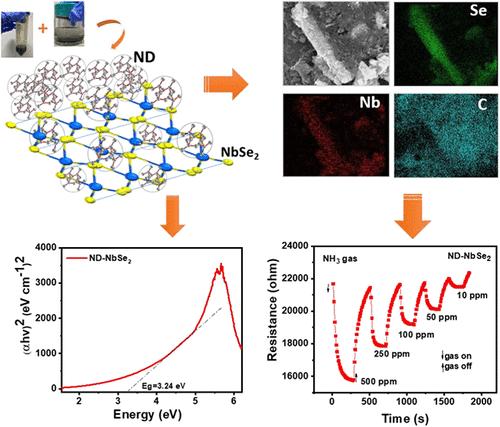二维NbSe2纳米结构纳米金刚石颗粒在室温下非均相掺杂用于高灵敏度氨气传感器
IF 8.2
2区 材料科学
Q1 MATERIALS SCIENCE, MULTIDISCIPLINARY
引用次数: 0
摘要
本文首次报道了一种用于室温氨(NH3)气敏的非均相纳米金刚石(ND)晶粒-二硒化铌(NbSe2)杂化物的开发。剥离的NbSe2纳米棒,可能通过声化学剥离形成,具有半导体行为,带隙为2.29 eV。ND - NbSe2杂种比原始NbSe2和ND表现出更高的NH3选择性。在较低浓度100 ppm下,ND(5.9%)和NbSe2(4.5%)的响应速度和恢复时间分别为81.2 s和70.6 s,达到了11.3%的显著提高。此外,与NbSe2相比,制备的ND对NH3气体的稳定性也很好。这解释了ND对ND - nbse2杂化异质结构的影响程度。此外,异质结的形成与样品电阻率的变化有关。这可以归因于ND晶粒(4.43 eV)和NbSe2纳米棒(2.29 eV)之间的能量间隙的相关性,这促进了电子在外加电压下从NbSe2的导带向ND的传输。此外,NbSe2-ND混合动力车在长期气体检测方面具有出色的稳定性。此外,预计该研究将激发2d - nbse2 -纳米金刚石杂化材料的发展,用于先进的气敏应用。本文章由计算机程序翻译,如有差异,请以英文原文为准。

Heterogeneous Doping of Nanodiamond Grains with Exfoliated 2D NbSe2 Nanostructures for Highly Sensitive Ammonia Gas Sensors at Room Temperature
Herein, a first-time report details the development of a heterogeneous nanodiamond (ND) grain-niobium diselenide (NbSe2) hybrid for room-temperature ammonia (NH3) gas sensing. Exfoliated NbSe2 nanorods, potentially formed via sonochemical exfoliation, exhibit semiconducting behavior with a band gap of 2.29 eV. The ND–NbSe2 hybrid demonstrates higher NH3 selectivity compared to pristine NbSe2 and ND. This hybrid achieves a significantly higher response of 11.3% with faster response and recovery times (81.2 and 70.6 s) than those of ND (5.9%) and NbSe2 (4.5%) at a lower concentration of 100 ppm. Also, the stability of the as-fabricated ND toward NH3 gas is exceptional when compared to that of NbSe2. This explains the level of influence of ND on the present ND–NbSe2 hybrid heterostructure. Moreover, the heterojunction formation with a change in the resistivity of the sample is involved in the sensing mechanism. This can be ascribed to the correlation of energy gaps between the ND grains (4.43 eV) and NbSe2 nanorods (2.29 eV), which promotes electron transportation from the conduction band of NbSe2 to ND at the applied voltage. In addition, the NbSe2–ND hybrids offer excellent stability for long-term gas detection. Furthermore, it is expected that this study will inspire the development of 2D-NbSe2–nanodiamond hybrid materials for advanced gas-sensing applications.
求助全文
通过发布文献求助,成功后即可免费获取论文全文。
去求助
来源期刊

ACS Applied Materials & Interfaces
工程技术-材料科学:综合
CiteScore
16.00
自引率
6.30%
发文量
4978
审稿时长
1.8 months
期刊介绍:
ACS Applied Materials & Interfaces is a leading interdisciplinary journal that brings together chemists, engineers, physicists, and biologists to explore the development and utilization of newly-discovered materials and interfacial processes for specific applications. Our journal has experienced remarkable growth since its establishment in 2009, both in terms of the number of articles published and the impact of the research showcased. We are proud to foster a truly global community, with the majority of published articles originating from outside the United States, reflecting the rapid growth of applied research worldwide.
 求助内容:
求助内容: 应助结果提醒方式:
应助结果提醒方式:


